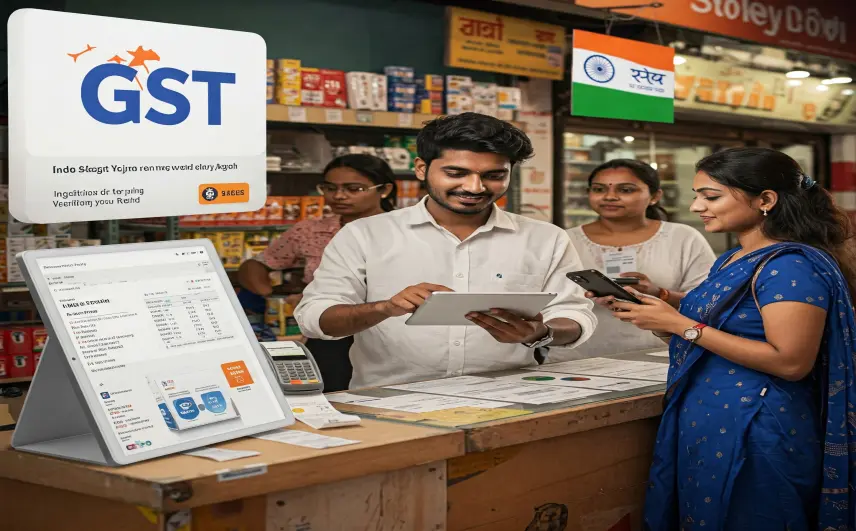GST Yojana: Complete Guide to Goods and Services Tax in India
GST Yojana: Revolutionizing Taxation in India
What is GST Yojana?
Introduced on July 1, 2017, the GST Yojana, or Goods and Services Tax, is a landmark tax reform by the Government of India. Replacing multiple indirect taxes like VAT, service tax, and excise duty, GST is a unified, destination-based tax system managed by the GST Council. It aims to simplify taxation, boost financial inclusion, and promote ease of doing business. As of 2025, GST has streamlined compliance through digital platforms and introduced measures like e-invoicing and amnesty schemes, with gross GST revenue reaching ₹1.59 lakh crore in August 2023.
Key Features of GST Yojana
- Unified Tax Structure: Consolidates central and state taxes into CGST, SGST, and IGST.
- GST Rates: Slabs of 0%, 5%, 12%, 18%, and 28%, with essentials at lower or nil rates.
- [](https://cleartax.in/s/gst-rates)
- Input Tax Credit (ITC): Allows businesses to offset taxes paid on inputs against output tax liability.
- E-Invoicing: Mandatory for businesses with turnover above ₹5 crore from August 2023, enhancing transparency.
- [](https://www.gstcouncil.gov.in/gst-council)
- GST Portal: Online platform for registration, return filing, and compliance at gst.gov.in.
- Composition Scheme: Simplified tax compliance for small businesses with turnover up to ₹1.5 crore.
- Amnesty Schemes: Waivers for late fees on GSTR-3B and GSTR-4 filings until March 2025.
- [](https://cleartax.in/s/gst-news-and-announcements)
Benefits of GST Yojana
The Goods and Services Tax has transformed India’s economy by:
- Eliminating tax cascading, reducing costs for consumers and businesses.
- Enhancing tax compliance through digital tools like the GSTN portal.
- Promoting ease of doing business with simplified registration and returns.
- Boosting exports with zero-rated supplies and seamless ITC refunds.
- Supporting small businesses via the Composition Scheme and QRMP (Quarterly Return Monthly Payment).
- Ensuring transparency with e-invoicing and the Invoice Management System (IMS).
Eligibility and How to Register for GST
GST registration is mandatory for businesses with an annual turnover exceeding ₹20 lakh (₹10 lakh in special category states) or those engaged in interstate supply. To register:
- Visit services.india.gov.in or the GST portal.
- Fill out Form GST REG-01 with PAN, Aadhaar, and business details.
- Verify via OTP or biometric-based Aadhaar authentication (available in select states).
- [](https://blog.saginfotech.com/gst-latest-updates)
- Submit documents like address proof, bank details, and business incorporation certificates.
- Receive GSTIN (GST Identification Number) upon approval, typically within 7 days.
eCommerce sellers and casual taxable persons must also register, regardless of turnover.
Recent Updates to GST Yojana (2025)
The GST Council and CBIC have introduced several updates to enhance compliance and ease taxpayer burden:
Impact of GST Yojana
Since its launch, GST Yojana has unified India’s tax system, reducing complexities and fostering economic growth. It has digitized compliance, with over 1.4 crore registered taxpayers by 2024. The GST Council’s periodic meetings, like the 55th in December 2024, ensure adaptive reforms, such as rate rationalization (e.g., EVs reduced to 5%) and anti-profiteering measures handled by the CCI since 2022.
Why GST Yojana Matters
The GST Yojana is a cornerstone of India’s economic reform, fostering transparency, reducing tax evasion, and enabling seamless trade across states. By aligning with global standards, it empowers businesses and consumers alike. Register today and leverage the benefits of Goods and Services Tax!
- Amnesty Scheme: Conditional waiver of late fees for GSTR-3B filings from July 2017 to April 2021, extended to March 31, 2025.
- [](https://cleartax.in/s/gst-news-and-announcements)
- E-Invoicing Deadline: 30-day reporting limit for businesses with turnover above ₹10 crore, effective April 1, 2025.
- [](https://cleartax.in/s/gst-news-and-announcements)
- Reduced Late Fees: GSTR-4 capped at ₹500 for nil filings, ₹2,000 for others; GSTR-7 late fee reduced to ₹50/day, max ₹2,000.
- (https://cleartax.in/s/gst-news-and-announcements)
- Invoice Management System (IMS): Optional “Supplier View” functionality on the GST portal for tracking recipient actions.
- (https://cleartax.in/s/gst-news-and-announcements)
- GST Registration Campaign 2025: CBIC’s Delhi East Commissionerate promotes awareness among unregistered traders.
- Exemptions: GST waived on water supply, public health services, and certain medicines like Dinutuximab for rare diseases.
Frequently Asked Questions
Customer Service Points (CSPs) often prompt questions about their functionality and benefits. FAQs clarify how CSPs bridge financial gaps in underserved areas.
Are there any recent amnesty schemes for GST?
Yes, a 2025 amnesty scheme waives late fees for GSTR-3B filings from July 2017 to April 2021, with forms SPL-01 and SPL-02 available by January 2025.
How does e-invoicing work under GST?
Mandatory for businesses with turnover above ₹5 crore, e-invoicing generates standardized digital invoices via the GST portal, ensuring transparency.
What is the Composition Scheme under GST?
The Composition Scheme allows small businesses with turnover up to ₹1.5 crore to pay a flat tax rate and file simpler returns.
What is Input Tax Credit (ITC)?
ITC allows businesses to deduct taxes paid on inputs from their output tax liability, reducing tax cascading and costs.
What are the GST rate slabs?
GST rates are 0%, 5%, 12%, 18%, and 28%, with essentials like food and healthcare at lower or nil rates.
What is GST Yojana?
Businesses with an annual turnover above ₹20 lakh (₹10 lakh in special category states), eCommerce sellers, and those in interstate supply must register.

